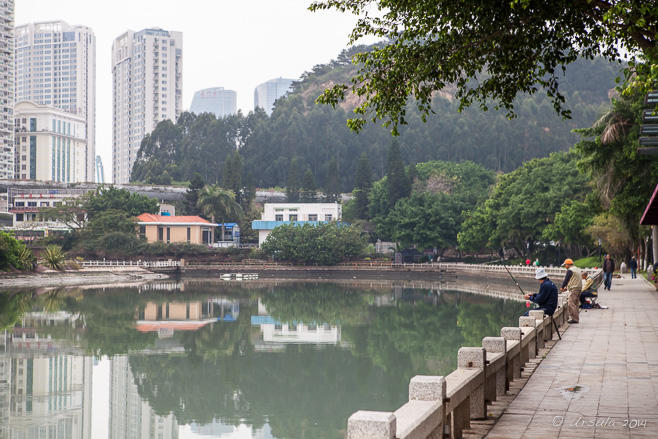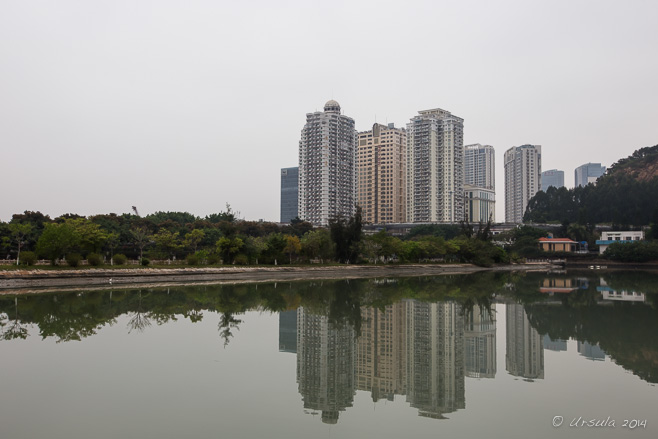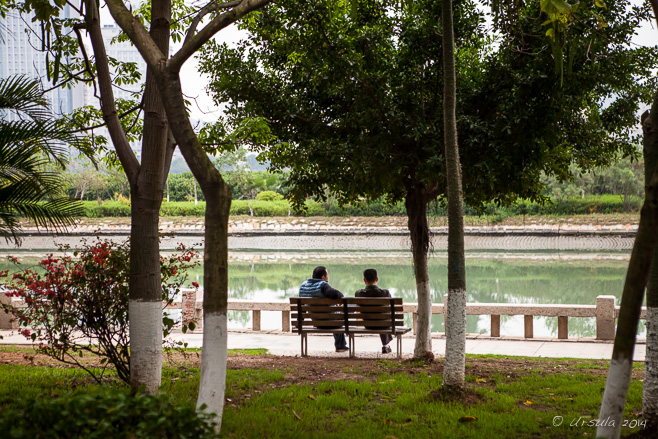
Fishing on Yundang Waihu
Just another day in Xiamen, China: men quietly fishing in timeless tradition on Yudang Lake, as the modern city rises up behind them.
Xiamen, an island-city on China’s southeast coast, has been ranked as China’s second “most suitable city for living” … as well as China’s “most romantic leisure city”, making it a popular destination for domestic tourists.
It is reasonably accessible to foreign tourists, as well. Some time ago, while my husband was busy with meetings in a nearby free-trade zone, I spent a few days following a dual-language map around the city.
First established during the Ming Dynasty (A.D. 1368-1644) as a major Chinese seaport, Xiamen – with its industrial-development, investment, and free-trade zones – continues to be an important land, sea, and air hub for Southeast Asia. Only 180 kilometres (110 mi) across the Taiwan Strait (Formosa Strait) from Taiwan, it considers itself an international city.
Rather ethnocentrically, I took “international” to mean Westernised, but although Gulangyu Island, a short ferry ride from downtown Xiamen, features Victorian-era European architecture, Xiamen itself is very Asian. Many of the Hokkien natives of this area emigrated to other countries in Southeast Asia during the 19th and early 20th century; many have returned with “foreign” (Asian) ideas, and some with money for universities and cultural institutions.
It is probably this free-flow of money and ideas that contributes to the “liveability” of the city: it has preserved the past in its temples (see: Nan Putuo Temple), forts, and other historical buildings (see: Gulangyu Island); it is surrounded by water and filled with parks, lakes, cultural buildings, and public art; and its university, the first university in China founded by overseas Chinese, helps the city look to its future.

Xiamen High-Rises
Yundang Waihu – Yundang Lake is a tranquil oasis in the city –

Around Yundang Waihu
– where locals walk, or fish or just sit.

Bailouzhou Park Entrance
In the middle of Yundang Lake is a large island park with four access points. Elaborate stone sculptured gates decorate one entrance.

Stone Sculpture
Other sculptures can be found within the large park – which also houses various recreation facilities.

“Keep the Environment Clean and Preserve Social Morality”
This is China: there are signs everywhere, telling us what to do!

Cotton Tree (Bombax Ceiba)
The park is a natural buffer against the city – for the local people, …

Cotton Tree (Bombax Ceiba)
… for lovers of beauty and nature, …

Lake Waterfront
… and for resident and migratory birdlife.

Steps down to the Harbour Waters
The Port of Xiamen is an important and busy deep-water port –

Swimmers in the Port
– but even so, swimmers, with their own life buoys, do their morning exercise in the chilly harbour waters.

Working Boats
The harbour is full of ferries –

Loaded Ferry
– laden with goods and/or passengers.

Woman on the Harbour
On a harbour walkway there is a sculpture of a woman waiting for the boats to come in.

Gulangyu Island
Across the sea mists, Gulangyu (Kulangsu) Island, a popular domestic tourist destination, is also accessible by ferry service.

Fruit Sellers
On the street, fresh-fruit sellers set up their rose-apple stands.

Street Scenes
A few blocks away, other fresh fruits are available on the sidewalk.

Two Men and a Fungus?
There is a plaque, in Chinese, explaining this art piece. I can’t even guess what they are doing, and could find no information on line – but it is another example of the sculptures dotted around the city.

“Poison to Raise Colour”
I think something has been lost in translation; sweet basil seeds are often used in Asian cooking, and are considered a super-food and slimming aide. But “poison?” Perhaps “potion”.

Lucky Turtles
Another sculpture has been erected under a tree in a major thoroughfare.

China Town?
A Chinese restaurant sits among some other old-style looking shop-fronts.

Stringing Beads
There are a variety of things available in the open-air markets on the wide city streets.

Mannequin
The shop-fronts make for fascinating window-shopping.

Walmart
This I did NOT expect! International, indeed.

University Entrance
Xiamen University makes the TripAdvisor list of places to visit. There was a special function on the day I tried, and only those with invitations were allowed in. I spent the afternoon at Nan Putuo Temple instead.

“A Brief Introduction to Hulishan”
Hulishan Fortress was built in the 1890s, during Emperor Guangxu’s reign, on a strong base made of camphor tree sap mixed with liquid brown sugar, glutinous rice, clay and sand.

Cannon Fire
When I arrived at the fort, “solders” in period dress were reenacting a cannon battle.

Standard Bearer
After the reenactment, …

Chinese Warrior
… the “soldiers” pose for photographs.

Early Cannons
For history buffs or munitions aficionados, Hulishan Fortress has a number of Chinese-made cannons, as well the “King of Cannons”, a 19th-century Krupp cannon from Germany – recognised by the 2000 Guinness Book of World Records as the oldest and largest coastal cannon on its original site in the world.

Coastal Cannons
However, I was more interested in the surrounds and the people tending the gardens.

Worker Sculpture
I also enjoyed the sculptures, dioramas, and murals, which brought the story of the fortress to life in a way all the signage around the 13,000 square metre site could not.

Ammunition Caisson
The views from the fort were nice, and would be pretty spectacular on a clear day. It was evident that the local visitors were enjoying their day out at a site of national historic importance to them.
When Britain took control of Hong Kong after the first Opium War, China opened five Treaty Ports, of which Xiamen (literally: “lower gate”; Amoy in local Min Nan dialect) was one.
Some take the name to refer to the city’s location at the mouth of the Nine Dragon River; the more poetic see it as referring to the city’s centuries-old role as a gateway to China.

Either way, it is an example of China at its most accessible.
Till next time,
Happy Travels!
Pictures: 01-04April2014




































.png)

